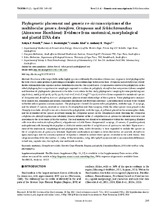| dc.description.abstract | "Ruschieae is the largest tribe in the highly speciose subfamily Ruschioideae (Aizoaceae). A generic-level phylogeny for
the tribe was recently produced, providing new insights into relationships between the taxa. Octopoma and Arenifera are woody
shrubs with multilocular capsules and are distributed across the Succulent Karoo. Octopoma was shown to be polyphyletic in the
tribal phylogeny, but comprehensive sampling is required to confirm its polyphyly. Arenifera has not previously been sampled
and therefore its phylogenetic placement in the tribe is uncertain. In this study, phylogenetic sampling for nine plastid regions
(atpB-rbcL, matK, psbJ-petA, rpl16, rps16, trnD-trnT, trnL-F, trnQUUG-rps16, trnS-trnG) was expanded to include all species
of Octopoma and Arenifera, to assess phylogenetic placement and relationships of these genera. Three phylogenetic analyses
were carried out, maximum parsimony, maximum likelihood and Bayesian inference. Leaf anatomical sections were studied
to further inform generic circumscriptions. The phylogenies showed Octopoma to be polyphyletic, with the type, O. octojuge,
and the related O. nanum, resolved as sister to Zeuktophyllum and Smicrostigma, while the other species were placed in the
Conophytum-clade. Arenifera was also shown to be polyphyletic, with the type, A. pillansii, placed in the xeromorphic-clade,
and the remainder of the species recovered among the Octopoma species in the Conophytum-clade (forming the Octopoma
subglobosum-Arenifera spinescens subclade). Generic affinities of the O. subglobosum-A. spinescens subclade were assessed
in relation to the sister taxon Schlechteranthus. The leaf anatomy was found to be informative within the study group. Bladder
cells were observed in Arenifera pillansii, a hypodermis in Little Karoo Octopoma (O. octojuge, O. nanum, O. quadrisepalum)
and epidermal cells forming blunt papillae in Schlechteranthus and the O. subglobosum-A. spinescens subclade. Upon assessment
of the anatomical, morphological and phylogenetic data, Schlechteranthus is here expanded to include the species in
the O. subglobosum-A. spinescens subclade. Eight new combinations are made in Schlechteranthus. As a result, Arenifera is
again monotypic and the circumscription of Octopoma is refined to include three species restricted to the Little Karoo. Two
subgenera within Schlechteranthus s.l. (subg. Schlechteranthus, subg. Microphyllus) are erected to accommodate differences
in leaf size, capsule size, closing body size and locule number." | |

